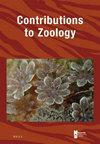Shrimps of the genus Periclimenes (Crustacea, Decapoda, Palaemonidae) associated with mushroom corals (Scleractinia, Fungiidae): linking DNA barcodes to morphology
IF 2.2
2区 生物学
Q1 ZOOLOGY
引用次数: 7
Abstract
Most marine palaemonid shrimp species live in symbiosis with invertebrates of various phyla. These associations range from weak epibiosis to obligatory endosymbiosis and from restricted commensalism to semi-parasitism. On coral reefs, such symbiotic shrimps can contribute to the associated biodiversity of reef corals. Among the host taxa, mushroom corals (Cnidaria: Anthozoa: Fungiidae) are known to harbour various groups of symbionts, including shrimps. Some but not all of these associated species are host-specific. Because data on the host specificity of shrimps on mushroom corals are scarce, shrimp species of the genus Periclimenes were collected from mushroom corals during fieldwork in Lembeh Strait, North Sulawesi, Indonesia. Using molecular (COI barcoding gene) and morphological methods, three species of Periclimenes were identified: P. diversipes, P. watamuae and a species new to science, P. subcorallum sp. nov., described herein. Their host specificity was variable, with eight, three and two fungiid host records, respectively. It is concluded that shrimp species of the genus Periclimenes show much overlap in their host choice and that particular morphological traits in the host species appear to play a more important role than phylogenetic affinities within the host group.与蘑菇珊瑚(硬核珊瑚属、真菌科)相关的围珊瑚属虾(甲壳纲、十足目、Palaemonidae):将DNA条形码与形态联系起来
大多数海洋古虾与各种门的无脊椎动物共生。这些关联范围从弱的附生到强制性的内共生,从有限的共生到半寄生。在珊瑚礁上,这种共生虾可以为珊瑚礁珊瑚的生物多样性做出贡献。在宿主分类群中,蘑菇珊瑚(刺胞纲:珊瑚虫纲:真菌科)被认为是各种共生体的避难所,包括虾。这些相关物种中的一些(但不是全部)是宿主特异性的。由于对虾在蘑菇珊瑚上寄主特异性的资料较少,在印度尼西亚北苏拉威西岛Lembeh海峡的实地调查中,从蘑菇珊瑚中采集了Periclimenes属虾种。利用分子(COI条形码基因)和形态学方法鉴定了3个种:P. diversity, P. watamuae和一个科学新种P. subcorallum sp. nov.。它们的宿主特异性是可变的,分别有8个、3个和2个真菌宿主记录。综上所述,周缘虾属虾种在寄主选择上有很大的重叠,寄主物种的特定形态特征似乎比寄主群体内的系统发育亲缘关系起更重要的作用。
本文章由计算机程序翻译,如有差异,请以英文原文为准。
求助全文
约1分钟内获得全文
求助全文
来源期刊

Contributions to Zoology
生物-动物学
CiteScore
4.00
自引率
4.50%
发文量
16
审稿时长
>12 weeks
期刊介绍:
Contributions to Zoology solicits high-quality papers in all systematics-related branches of comparative zoology (including paleozoology). Preference will be given to manuscripts dealing with conceptual issues and to integrative papers (e.g., ecology and biodiversity, morphology and phylogeny and character state evolution, phylogeny and historical biogeography, systematics and bioinformatics, bioinformatics and biodiversity, habitat disturbance and biogeography, etc.). Reviews and alpha-taxonomic contributions are considered for publication, but acceptance will depend on their high quality and exceptional nature.
 求助内容:
求助内容: 应助结果提醒方式:
应助结果提醒方式:


